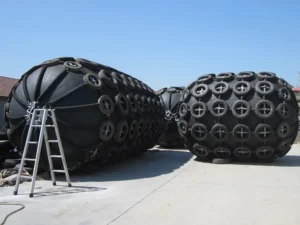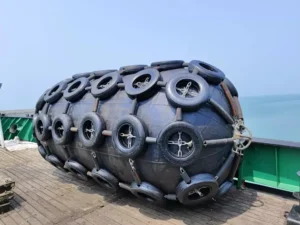Introduction
Do you know what safely helps in the berthing process of ships? They are the different types of fenders that not only absorb the collision but also help in several accidents occurring in marine. One of the best types coming up on the top is the pneumatic fender. But they have another Yokohama fender. Today, we will understand why we call it the Yokohama Fenders and where it comes from initially.
Let’s have a detailed discussion!
The origin of marine fenders
Have you ever wondered what people used for protection during a collision? Were there Yokohama marine fenders in the beginning or not?
The simple answer is no. Before World War 2, there was no concept of pneumatic fenders for ships. People used to collect the whale skin, especially in Japan, and used it to absorb the collision energy.
Guess what? It was very effective in protecting during a collision. But grabbing the whale carcass was a bit of a hectic task. In Japan, it was done for hunting purposes. Therefore, the carcass concept also came from Japan.
But there were many problems with the whale carcass.
- It was difficult to hunt down a whale and kill it to peel off the skin.
- After some days, whale skin started to produce toxic gases. That was a risk factor for human life.
- Unpleasant smells also caused several problems for the people.
The Western world continuously struggled to find a better and more reliable solution. Then came the Yokohama fenders.
When were Yokohama marine fenders were invented?
Maybe you wonder when were the floating pneumatic rubber fenders introduced. It was 1958 when the Yokohama Rubber Company From Tokyo, Japan, developed fenders.
But there was a big problem with the size. If the company had to make it full of rubber, it would require a handsome quantity of rubber that was difficult to achieve and expensive. So, everyone couldn’t afford it. After a thorough research, they came up with the pneumatic technology.
So, what was the first Fender at that time?
It was an air-filled cylindrical ball of rubber used to compress and absorb all the collision energy. Over time, the company has improved its pneumatic filling and provided users an affordable option.
To generalize using the Yokohama Fender, ISO issued the certifications to reliable manufacturers. Today, we find the use of a Yokohama Pneumatic Fender everywhere.
Why do we call it a Yokohama pneumatic rubber fender?

That is an exciting question flashing through the minds of people. But do you know the first manufacturer? It was the Yokohama rubber company. They introduced it as the Yokohama Fender. Since it has a high-pressure air filled in the material, we call it pneumatic.
That is how the name came from Japan. Now, there are many manufacturers around the globe producing high-quality fenders.
The rise of Yokohama pneumatic rubber fender
1958 was just the beginning of a new era of the rubber fenders. Today, the pneumatic rubber fender Yokohama stands out as a valuable safety tool that must be available on every shore and boat.
From the 1950s to the 2020s, Yokohama pneumatic fenders have come a long way, spreading worldwide. They are critical tools in ship-to-ship or ship-to-berth applications and help in safety.
Nowadays, on every port, you can find such fenders. Plus, the improving technology has boosted its performance with the new tactics.
Are Yokohama Fenders Worth it for your vessel Application?

Yes. One hundred percent. If you want to ensure the safety of your boats in various applications, look no further than the Yokohama fenders. They have multiple advantages regarding the price, maintenance, and berthing. Let’s know!
-
Helpful in inclined berthing
Inclined berthing is a crucial phenomenon that increases the hassle of the work. In the bergting, first contact is often at 45 degrees. It exerts impact on the dock and boat.
Solid fenders fail at this point due to inclined compression in this part that does not offer a lot of energy to absorb during the berthing phase. Compared to it, pneumatic fenders contain high-pressure air ready to undertake the high compression force generated during the inclined berthing.
It shifts most of the pressure to its body and prevents damage during berthing. The primary role has been beneficial in this case.
-
Absorb shearing force
Contact of the boat with the dock does not mean it has been moored. The slow movement puts a shearing force. Solid fenders are not very effective in such a scenario.
Pneumatic fenders have a high strength to absorb shearing force and help in the mooring process. You are more than safe with the pneumatic fenders.
-
Work in extreme conditions
Whatever season is around or even when heavy tides are in the ocean, Yokohama fenders still work. They can perform at -50 degrees Celsius. It is impressive when you can use it in every situation and get the best performance.
In harsh environments, they are suitable due to their strength, whereas a solid fender won’t help much.
-
Minimal performance loss
Aging is a standard process not only for living things but also for non-living matters such as rubbers. That is why a solid rubber fender, after years of work, starts losing performance due to energy absorption.
Don’t worry about the performance losses in the Yokohama floating fenders. They don’t lose strength, all thanks to the air filled in them. Whenever you think they are not optimally performing, consider the air-filling and a bit of maintenance. All this will ensure a quick return to the previous performance you expect from a fender.
-
Simple to install
If you are an amateur, you can install the Yokohama Fenders. They are easy to install because of their lightweight and easy-to-understand mechanisms.
Moreover, they are easy to transfer from one place to another.
-
Cheaper and Easy to maintain
Do you know the best thing about the pneumatic fenders? They are super cheap. Why? Because of the high pressure, that is almost free. There is not very much use of the rubber. Therefore, the overall cost of the pneumatic fenders is significantly less compared to the same variety of the solid fenders.
One more thing — you do not have to maintain it daily. For maintenance, you can monitor the pressurized air and external look. It will lose strength and tone when air goes out. Monthly or yearly maintenance also saves you some bucks, making it a worthwhile deal.
What are the applications of the Yokohama fenders?

Yokohama fenders have diverse applications in various industries. Take a quick review of the different applications of Yokohama fenders.
-
Ship to Ship Offshore operations
During the journey on the ocean, ships have to transfer containers or some other tools from one ship to another. To build a connection, both ships have to come close and get connected. It can be a risky task because waves of water produce motion and collision forces.
Yokohama fenders provide the necessary cushion and absorb all the force. It results in various offshore operations from one ship to another.
-
Ship berthing
Ship berthing is a complex process. Whether it is permanent or temporary berthing, the process generates a lot of risks for damage to the ships. When a boat is near the berthing place, it might need an inclined berth force.
Yokohama fenders stand out as the sole and loyal helper in this case. They ease up the whole berthing process and optimize the health of the boats.
-
Oil and Natural Gas Tankers
Do you know how the transfer of oil from one country to another occurs? Air transport is not an effective method because of various ignition risks. Sea transport is a fantastic and affordable option.
Yokohama fenders help in ensuring the safety of the transport by supporting the oil cargo. In case of berthing or collisions, there is no problem when Yokohama fenders are there.
-
Temporary installations uses
Even if you want a temporary installation of the fenders on the berth places, Yokohama fenders enable it—easy-to-transport features and compact design save time and help in the quick installation.
Many places around the ships and ports need regular replacements and temporary installations. Pneumatic fenders are preferred to solid fenders at such places.
-
Collision protection applications
Whether it is a collision between the two boats or a collision at the landing site between the boat and landing place, Yokohama fenders have practical uses at both places. High power absorption features ensure their long-lasting use in this industry.
Conclusion
Exploring a top-quality marine fender is an upper-edge choice for your boats. You’ll get a long-lasting solution without much worry about the fenders.
Do you want the top-quality marine fenders?
Remember the name —Jerry Borg Marine. We have 15+ years of experience in the fenders industry and produce premium quality pneumatic fenders for ships. Explore our top Yokohama fender sizes now!
